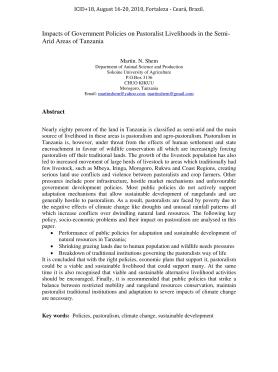Impacts of Government Policies on Pastoralist Livelihoods in the SemiArid Areas of Tanzania
Impacts of Government Policies on Pastoralist Livelihoods in the SemiArid Areas of Tanzania
Nearly eighty percent of the land in Tanzania is classified as semi-arid and the main source of livelihood in these areas is pastoralism and agro-pastoralism. Pastoralism in Tanzania is, however, under threat from the effects of human settlement and state encroachment in favour of wildlife conservation all which are increasingly forcing pastoralists off their traditional lands. The growth of the livestock population has also led to increased movement of large herds of livestock to areas which traditionally had few livestock, such as Mbeya, Iringa, Morogoro, Rukwa and Coast Regions, creating serious land use conflicts and violence between pastoralists and crop farmers. Other pressures include poor infrastructure, hostile market mechanisms and unfavourable government development policies. Most public policies do not actively support adaptation mechanisms that allow sustainable development of rangelands and are generally hostile to pastoralism. As a result, pastoralists are faced by poverty due to the negative effects of climate change like droughts and unusual rainfall patterns all which increase conflicts over dwindling natural land resources. The following key policy, socio-economic problems and their impact on pastoralism are analysed in this paper.

